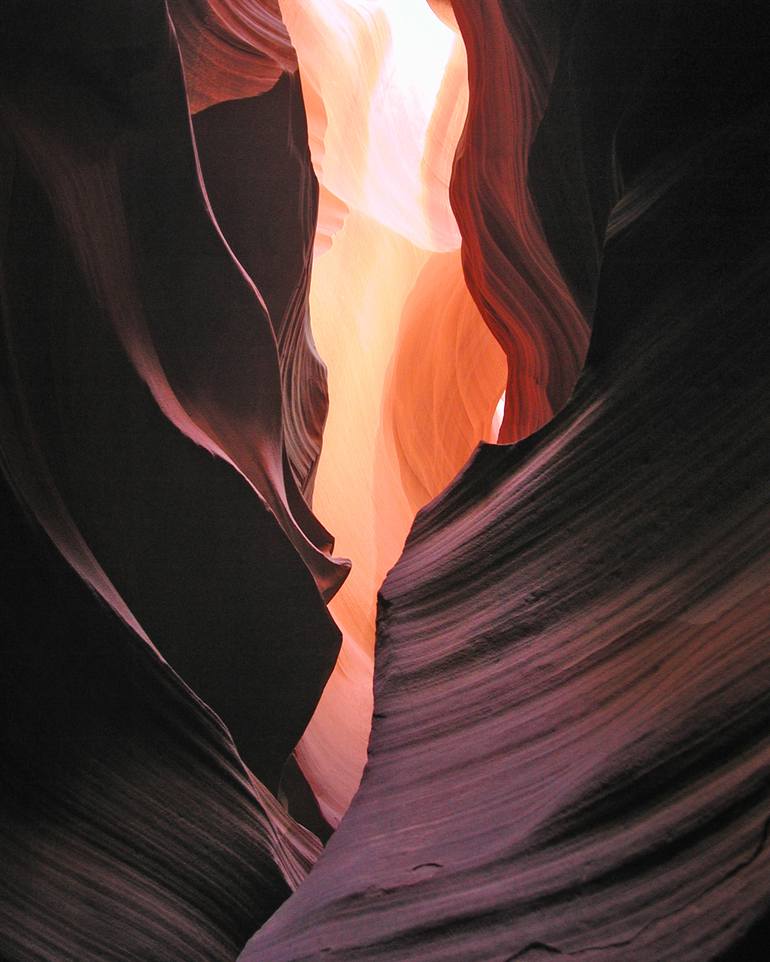


VIEW IN MY ROOM
Twisted Canyon Photograph
United States
Photography, Digital on Canvas
Size: 16 W x 20 H x 0.1 D in
About The Artwork
Antelope Canyon is the most-visited and most-photographed slot canyon in the American Southwest. It is located on Navajo land near Page, Arizona. Antelope Canyon includes two separate, photogenic slot canyon sections, referred to individually as Upper Antelope Canyon or The Crack; and Lower Antelope Canyon or The Corkscrew. This photography was taken in Upper Antelope Canyon. *** *** *** *** *** Antelope Canyon was formed by erosion of Navajo Sandstone, primarily due to flash flooding. Rainwater, especially during monsoon season, runs into the extensive basin above the slot canyon sections, picking up speed and sand as it rushes into the narrow passageways. Over time the passageways are eroded away, making the corridors deeper and smoothing hard edges in such a way as to form characteristic 'flowing' shapes in the rock. Flooding in the canyon still occurs. A flood occurred on October 30, 2006 that lasted 36 hours, and caused the Tribal Park Authorities to close Lower Antelope Canyon for five months. *** *** *** *** *** Antelope Canyon is a popular location for photographers and sightseers, and a source of tourism business for the Navajo Nation. It has been accessible by permit only since 1997, when the Navajo Tribe made it a Navajo Tribal Park. Photography within the canyons is difficult. *** *** *** *** *** Upper Antelope Canyon is called Tsé bighánílíní, "the place where water runs through rocks" by the Navajo. It is the most frequently visited by tourists, due to two considerations. First, its entrance and entire length are at ground level, requiring no climbing. Second, beams (shafts of direct sunlight radiating down from openings in the top of the canyon) are much more common in Upper than in Lower. Beams occur most often in the summer months, as they require the sun to be high in the sky. Winter colors are a little more muted. *** *** *** *** *** Lower Antelope Canyon, called Hazdistazí, or "spiral rock arches" by the Navajo, is located a few kilometers away. Prior to the installation of metal stairways, visiting the canyon required climbing along pre-installed ladders in certain areas. Even following the installation of stairways, it is a more difficult hike than Upper Antelope—it is longer, narrower in spots, and even footing is not available in all areas. At the end, the climb out requires several flights of stairs. The lower canyon is in the shape of a "V" and shallower than the Upper Antelope. Lighting is better in the early hours and late afternoon. *** *** *** *** *** Antelope Canyon is visited exclusively through guided tours, in part because rains during monsoon season can quickly flood the canyon. Rain does not have to fall on or near the Antelope Canyon slots for flash floods to whip through, as rain falling dozens of miles away 'upstream' of the canyons can funnel into them with little prior notice. On August 12, 1997, eleven tourists, including seven from France, one from the United Kingdom, one from Sweden and two from the United States, were killed in Lower Antelope Canyon by a flash flood. Very little rain fell at the site that day, but an earlier thunderstorm had dumped a large amount of water into the canyon basin, seven miles upstream. The lone survivor of the flood was tour guide Francisco "Poncho" Quintana, who had prior swift-water training. At the time, the ladder system consisted of amateur-built wood ladders that were swept away by the flash flood. Today, ladder systems have been bolted in place, and deployable cargo nets are installed at the top of the canyon. *** *** *** *** *** The road to Antelope Canyon is gated by the Navajo Nation and entry is restricted to guided tours led by authorized tour guides. Tours can be purchased in nearby Page, Arizona and range from $30 to $80 per person, depending on the time of the day and length of the tour. *** *** *** *** *** most text above quoted/paraphrased from wikipedia.org
Details & Dimensions
Photography:Digital on Canvas
Original:One-of-a-kind Artwork
Size:16 W x 20 H x 0.1 D in
Frame:Not Framed
Ready to Hang:No
Shipping & Returns
Delivery Time:Typically 5-7 business days for domestic shipments, 10-14 business days for international shipments.
Have additional questions?
Please visit our help section or contact us.
United States
Alan and Marcia, Nevada residents, are avid photographers. Alan takes many photos while hiking around the area - you will see some of his dramatic landscape photos in our portfolio. Marcia looks at things from a different perspective - her photos are usually still life or photos of objects that she finds interesting or unique. Together, they present the eclectic display of photos which you see here. As you can see, Marcia is camera-shy - she would rather be behind the lens than in front of it. Please feel free to share our photographs with family, friends, or associates... We occasionally send out "Limited Time Discounts" - this provides an opportunity to buy our artwork at incredible savings. If you would like to receive announcements of events or periodic promotional sale prices, please click on "Subscribe" from the profile page on our website: http://alan-and-marcia-socolik.artistwebsites.com. We have a large collection of fine art photos we have not posted yet - if you have specific interests or subject matter you would like to see, contact us to let us know. Thanks for viewing our images.
Thousands Of Five-Star Reviews
We deliver world-class customer service to all of our art buyers.
Global Selection
Explore an unparalleled artwork selection by artists from around the world.
Satisfaction Guaranteed
Our 14-day satisfaction guarantee allows you to buy with confidence.
Support An Artist With Every Purchase
We pay our artists more on every sale than other galleries.
Need More Help?